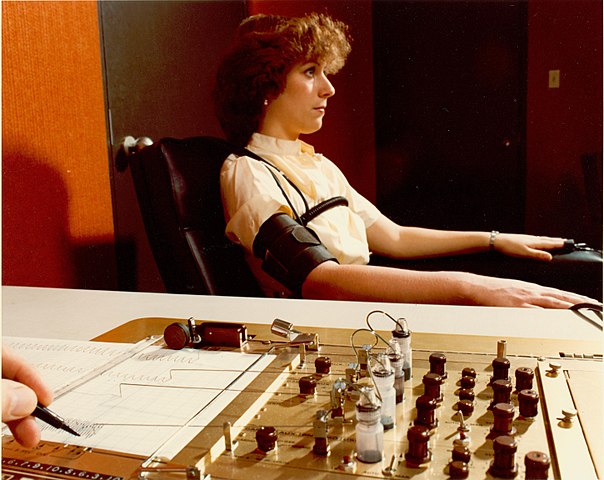
How does a lie detector work? Lie detectors work by recording breathing rate, pulse, blood pressure, muscular activity, and perspiration to look for any changes. They are not admissible in court because they don’t always work.
The modern lie detector (polygraph) was created in 1945, but there were many steps along the way. The first polygraph was invented in 1895 by Cesare Lombroso, which measured changes in blood pressure. In 1904, Vittorio Benussi added a way to test breathing speed as well. An American called William Moulton Marston took up the idea of the lie detector and he worked hard to get it used in American courts. He also invented the Wonder Woman cartoon character as well, with her lasso of truth. A device that could measure skin response as well was first used in 1939 by the FBI. Further changes were added until there was a device in 1945 that could do most of what modern devices could do. Today, the recording is digital and all of the sensors are far more delicate, but the idea remains the same.
The name polygraph was given to the machine in 1921. “Poly” is Greek for many and “graph” is Greek for writing. It was created in 1871 to apply to a machine that could read different bodily signals, not for the purpose of detecting lies.
The basic idea behind a lie detector is that telling a lie and trying not to be caught is a stressful experience. People who read body language say that they can tell when someone is lying because of where they look, their body language, the words and grammatical structures they use, and a host of other things. They probably can, but someone who is adept at lying could work to cover these things. The theory behind a polygraph is that you can learn to mask your gestures, but you cannot mask your body’s natural functions. When you tell a lie you will get stressed and your body will have a stress response. Your heart rate will go up, your breathing will speed up, your blood pressure will rise, your muscles will tense slightly, and you will sweat more. That is what a polygraph is measuring and they are so delicate that they can measure even very slight changes.
The heart rate, blood pressure, and breathing rates are fairly simple to measure, which is why the earliest polygraphs focused on those. Muscles tensing requires devices that can measure the electrical signals across muscles and sweating is measure in the same way. Sweat is measured with a galvanic skin response detector. When you sweat, your body releases water mixed with salt because it wants to make sure the salt levels in your body stay the same as you lose water. Salt conducts electricity more readily than just water or just skin and the detector can measure this electrical difference.
When you go in for a lie detector test, the technician will wire all of the sensors to you. Before the test starts, the technician will stress how effective these tests are because that will increase the likelihood of a reaction when someone lies. The technician will ask a few questions to start with to gain a baseline and they will ask the person to lie once. The technician will announce that they detected the lie, whether they did or not, to emphasize the effectiveness of the test and to increase the stress a guilty person will feel. Then the technician will ask questions, mixing in questions that are not connected or questions they know to be true to make sure that their baseline is accurate. Afterwards, the technician will go over the data and look at the responses. In theory, tying these physical responses to the question will show when someone was lying.
Polygraph technicians claim to be able to spot lies over 80% of the time. This is why polygraphs used to be admissible in court to help prove whether someone was guilty or innocent. They were disallowed when research revealed that they were actually far less effective than the technicians claimed. The problems are that innocent people can become extremely nervous when questioned in such a situation and produce a false positive. Another problem is that there are tactics to avoid a physical response on difficult questions. One is to pinch yourself really hard on all of the diagnostic questions. This will produce a pain response, which is identical to a stress response, making it impossible to tell lies from the truth. Another method is to just be calm. A third problem is that some people who have committed crimes don’t feel emotions in a normal way and would probably pass a lie detector. It is likely that innocent people have been found guilty and guilty people have been found innocent on the strength of polygraph results. And this is what I learned today.
Liked this? Try these:
Sources
https://en.wikipedia.org/wiki/Polygraph
https://science.howstuffworks.com/question123.htm
https://www.etymonline.com/word/polygraph
https://www.healthline.com/health/why-is-sweat-salty#downsides
Image By Federal Bureau of Investigation – https://multimedia.fbi.gov/large/3341, Public Domain, https://commons.wikimedia.org/w/index.php?curid=63821903
